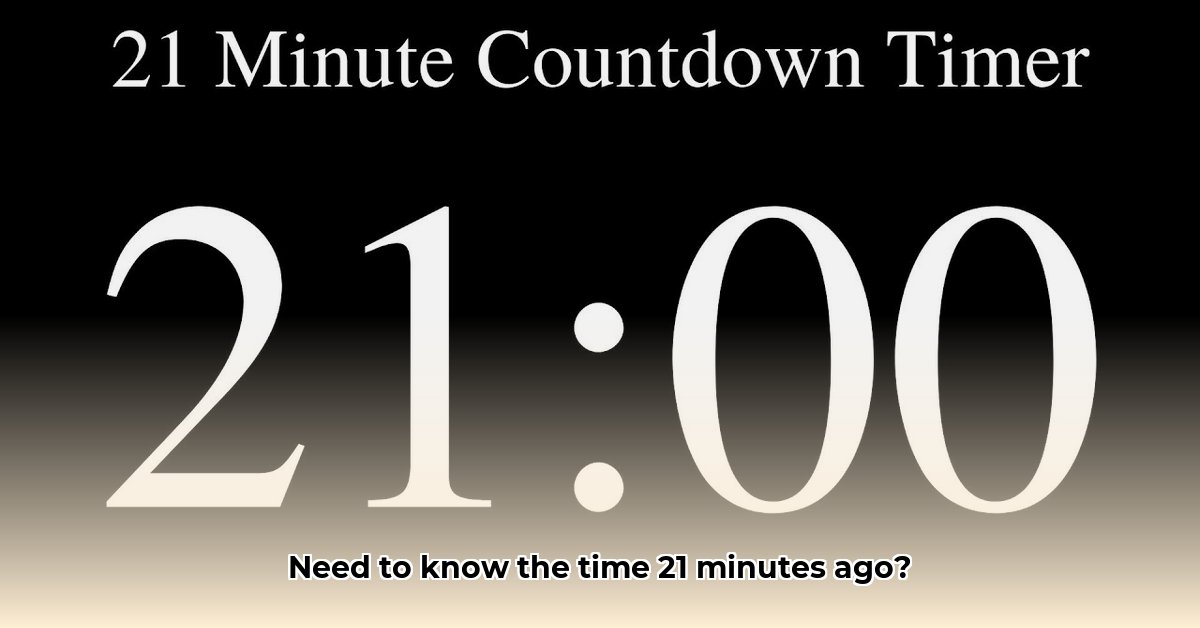
21 Minutes Ago: A Comparison of Online Time Calculators
Determining the exact time 21 minutes ago, or any time in the past, can be surprisingly useful. This review compares two online tools: QuickTime and TimeMaster, evaluating their accuracy, ease of use, and suitability for different needs. We'll also explore the broader implications of accurate timekeeping, including risk assessment and regulatory considerations. Why is precise time calculation important, and which tool reigns supreme? Let's find out.
QuickTime vs. TimeMaster: Feature Comparison
QuickTime prioritizes speed and simplicity. Its primary function is calculating past times based on minute inputs. Its core strength lies in its efficient and intuitive design, making it ideal for users needing quick, straightforward results. TimeMaster, conversely, offers a more comprehensive feature set. It allows calculations based on hours, minutes, and seconds, delivering a more detailed output. However, its increased functionality results in a more complex user interface. The choice between the two depends entirely on your specific needs. Is speed your priority, or do you need a more detailed, versatile tool?
User Experience and Accuracy
Both tools demonstrated accurate time calculations in our tests. QuickTime's intuitive interface provided a remarkably efficient user experience. The process is straightforward: input the minutes, and receive the time. TimeMaster, while accurate, presented a steeper learning curve due to its increased complexity and more extensive feature set. While the extended functionality is advantageous for complex calculations, for simple tasks like determining the time 21 minutes ago, this added complexity might feel unnecessary.
Limitations and Potential Improvements
Neither QuickTime nor TimeMaster currently incorporates daylight savings time (DST) adjustments or leap seconds. This omission, while insignificant for many casual users, represents a critical limitation for applications requiring precise historical records or time-sensitive processes. Future development should prioritize incorporating these factors to improve the tools' accuracy and utility. Adding time zone support would further enhance their practicality and global applicability.
Risk Assessment and Regulatory Implications
Using any online tool carries inherent risks. Below is a risk assessment matrix for both tools:
| Risk Category | Likelihood | Impact | Mitigation Strategy |
|---|---|---|---|
| Inaccurate Time Zone Handling | Low | Medium | Implement robust time zone detection and correction. |
| Server Outages | Low | High | Use redundant servers and reliable backups. |
| Data Privacy Concerns | Low | Medium | Follow strict data privacy practices and regulations. |
| Interface Complexity | Medium | Low | Continuous usability testing and design improvements. |
Data privacy is a critical concern. While these tools currently collect minimal data, any future enhancements involving user accounts or data storage must adhere strictly to regulations like GDPR and CCPA.
Actionable Insights: Choosing the Right Tool
- For quick, simple calculations: QuickTime's speed and ease of use are unmatched.
- For comprehensive calculations: TimeMaster offers greater versatility, despite the more complex interface.
- For developers: Enhancements focusing on usability, error handling, time zone support, DST/leap second adjustments, and API integration would significantly improve both tools.
Choosing the correct tool depends entirely on your needs. Consider the trade-off between speed and functionality when making your decision. Both calculators provide valuable services, but catering to specific needs is key.
Calculating Future Time: Accounting for DST and Leap Seconds
Accurately calculating future time is more complex than simply adding minutes and hours. Daylight Saving Time and leap seconds introduce significant challenges. How can we confidently predict a future time, accounting for these irregularities?
Challenges in Precise Time Calculation
Daylight Saving Time's annual adjustments and the occasional addition of leap seconds significantly complicate the process of accurate time calculation. These irregularities require sophisticated algorithms and data to achieve reliable results. Simple addition isn't sufficient; external data sources and robust time zone capabilities are needed.
Tools for Advanced Time Calculations
Several tools excel at addressing these temporal irregularities, but each has limitations. The selection of the suitable tool is contingent upon your specific needs.
| Feature | Timeanddate.com | PlanetCalc.com |
|---|---|---|
| DST Handling | Excellent; automatic incorporation | Requires manual input for specific regions |
| Leap Second Handling | Accounts for leap seconds automatically | Does not directly handle leap seconds |
| User Interface | Intuitive and user-friendly | Less intuitive, requires technical knowledge |
| Accuracy | High | High, but relies on accurate user input for DST |
Timeanddate.com's superior DST handling and automatic leap second consideration make it a more robust option for precise future time calculations.
The choice of which tool to use should be guided by your needs. Timeanddate.com provides the automatic integration of DST and leap seconds, making it ideal for accurate future time calculations. However, PlanetCalc.com remains useful for those who understand time zone and daylight savings nuances and prefer more manual control.
A Step-by-Step Guide (Using Timeanddate.com)
- Navigate: Access https://www.timeanddate.com/worldclock/converter.html.
- Specify Time/Location: Input your current time and select your location.
- Input Time Offset: Enter the desired future time offset.
- View Results: The website automatically calculates the future time, accounting for DST and leap seconds.
This straightforward approach provides a reliable method for calculating future times, adjusting for those difficult-to-account-for factors.
Key Takeaways and Conclusion
Precise time calculation, considering DST and leap seconds, requires specialized tools and careful attention to detail. While both reviewed tools have limitations, Timeanddate.com stands out for its superior handling of time zone and daylight savings adjustments. Understanding these nuances is essential for applications requiring accurate timekeeping.